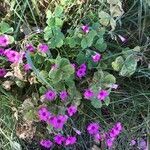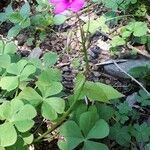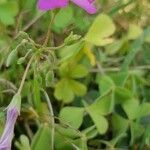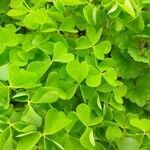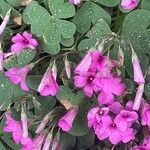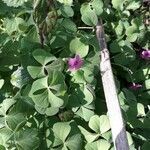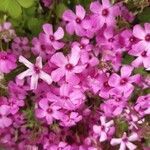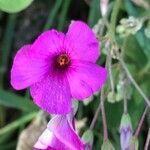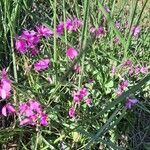Perennial herb with stems not evident; rhizome stout, woody, irregularly nodulose-segmented to c. 15 cm long, to c. 2.5 cm diam., often covered with persistent old petiole-bases; bulbs and bulbils absent. Indumentum of simple eglandular hairs. Stipules membranous, tapering into petiole, the stipular wing inconspicuous, hairy. Leaves basal, crowded at apex of rhizome, trifoliolate; petiole (3–) 7–30 cm long, sparsely hairy; leaflets sessile, obcordate, usually 8–35 (–55) mm long, 10–45 (–60) mm wide, deeply notched (sinus to c. one-third leaflet length), green, sparsely pubescent above and below, margins ciliate, with basal tuft of hairs; lobes oblong to obovate, apices rounded and 8–16 mm apart; calli forming a marginal band, orange. Inflorescences usually umbelliform cymes, less commonly in irregular cymes, basal, (1–) 3–30-flowered; peduncles slightly longer than leaves, 12–35 cm long, sparsely strigose; pedicels 10–25 mm long, sparsely to moderately hairy. Bracts situated at base of pedicels, lanceolate to ovate, 2–2.5 mm long, with 2 elongated orange calli. Flowers tristylous (long-styled, mid-styled and short-styled). Sepals lanceolate, 3–5 mm long, green, with appressed hairs; calli 2, orange, apical. Petals oblique-obovate to oblong, 9–16 mm long, usually deep pink to magenta with darker veins, sometimes pale pink or rarely white, with band of appressed hairs outside. Stamens at 2 levels; filaments hairy, dilated and sometimes toothed in lower part, those of longest whorl 2–3 mm long. Ovary sparsely strigose. Styles densely hairy. Capsules not developed in Australia.
Clump-forming, hairy perennial; rhizomes short, thick, fleshy, sometimes with short offsets, rough from numerous lf base scars. Lvs 3-foliolate, in basal rosettes. Petiole (3)-7-30 cm long, hairy or nearly glabrous; stipular wing inconspicuous, membranous, hairy. Lamina of leaflets often unequal, sessile, usually 8-35-(55) × 15-(60) mm, broadly obcordate with narrow sinus to ⅓ lamina, with appressed hairs above and below, with basal tuft of hairs; calli orange and forming marginal band; lobes 2, rounded. Infl. to c. 35 cm tall, glabrate, a terminal cyme or panicle of (4)-7-35 fls; pedicels ± deflexed at first, later erect, very variable in length, with antrorse hairs. Bracts at base of pedicels 2-2.5 mm long, lanceolate to ovate, with 2 elongated orange calli. Sepals 3-5 mm long, ovate-elliptic or elliptic, with appressed hairs; calli 2, orange, terminal. Petals 9-16 mm long, oblique-obovate to oblong, usually rose above with darker veins and paler pink with band of appressed hairs outside, rarely white. Stamens in 2 whorls; filaments hairy, dilated and sometimes toothed in lower part, those of longest whorl 2-3 mm long. Styles usually much > longer stamen whorl at anthesis (if petals white, then much < longer stamen whorl), densely hairy. Capsule not seen.
the hairs straight; petals violaceous, obovate-oblong, clawed, connate near the middle, 2-3 times the length of the sepals, the areas exposed in bud covered with white sericeous appressed hairs; stamens with linear filaments, basally broad and abruptly narrowed about the middle, the longer stamens 3.5 mm long, pubescent, the shorter stamens 2 mm long, glabrous, connate to about 2/3, the anthers ovoid; pistils macro-, meso-and microstylous, ca. 5.5 mm long, the ovary pilose at least at the apex and back of the carpels, carpels 4-8-ovuled, the styles densely pilose, the stigma small, capitate. Capsule cylindric or oblong, acute, 8-11 mm long, the calyx to ?2 of its length, densely ascending appressed pubescent overall or only at the apex of the carpels, the carpels 4-8-seeded; seeds light brownish, ovoid or ellipsoid, acute at both ends, 1-1.25 mm long, 8-9-ribbed in zig-zag, transversally striate with 4-8 deep pits.
Herbs perennial, acaulous, rhizomes present, <thick, woody, irregularly nodulate-segmented, often covered with persistent petiole bases>, stolons absent, bulbs absent. Leaves basal; petiole 11–30 cm; leaflets 3, green to purplish abaxially, green adaxially, rounded-obcordate, 18–20 mm, <margins densely loosely ciliate>, lobed 1/5–1/3 length, <lobes apically convex>, surfaces evenly strigose-villous to strigose-hirsute, oxalate deposits in dots concentrated mostly toward margins or over whole surface. Inflorescences usually umbelliform cymes, less commonly in irregular cymes, 3–12-flowered; scapes 12–28 cm, sparsely strigose. Flowers heterostylous; sepal apices with 2 orange tubercles; petals usually purplish rose to red, rarely white, 10–14 mm. Capsules ovoid, 4–8 mm, sparsely strigose. 2n = 42.
A herb that has a thick, erect, woody underground stem or rhizome. It does not produce bulbs. It grows 30-40 cm high and spreads 30-40 cm wide. The leaves are made up of 3 leaflets. They are 25 mm across. These are covered with short downy hairs. The flowers have 5 free petals. These are pink or white. They are 18 mm across and held above the leaves.
